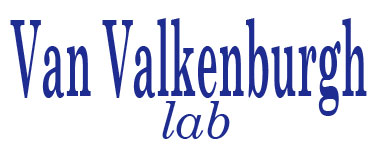RECENT PUBLICATIONS FROM THE VAN VALKENBURGH LAB
2020
- Smith TD, VanValkenburgh B. The dog–human connection. AnatRec. 2021;304:10–18.
- Bird DJ, Jacquemetton C, Buelow SA, Evans AW, Van Valkenburgh B. Domesticating olfaction: Dog breeds, including scent hounds, have reduced cribriform plate morphology relative to wolves. Anat Rec. 2020.1–15.
- Jacquemetton C, Drexler A, Kellerman G, Bird D, Van Valkenburgh B. The impact of extreme skull morphology in domestic dogs on cribriform plate shape. Anat Rec. 2020.1–12.
- Balisi, M.A., Van Valkenburgh, B. Iterative evolution of large-bodied hypercarnivory in canids benefits species but not clades. Commun Biol 3,461 (2020).
- Bird DJ, Hamid I, Fox-Rosales L, Van Valkenburgh B. Olfaction at depth: Cribriform plate size declines with dive depth and duration in aquatic arctoid carnivorans. Ecol Evol. 2020.10:6929–6953.
Pre-2009
- Kitchener, A. Van Valkenburgh, B, and Yamaguchi, N. Felid form and function. In. Macdonald, D. W, and Loveridge, A, (eds) Biology and Conservation of Wild felids. Oxford Univ. Press, Oxford (in press).
- Binder, W. J. and Van Valkenburgh, B. A comparison of tooth wear and breakage in Rancho la Brea sabertooth cats and dire wolves across time. Journal of Vertebrate Paleontology (in press).
- Meachen-Samuels, J. and Van Valkenburgh, B. 2009. Craniodental indicators of prey size preference in the Felidae. Biological Journal of the Linnean Society 96. 784-799.
- Slater, G. J. and Van, Valkenburgh, B. 2009. Allometry and performance: the evolution of skull form and function in felids. Journal of Evolutionary Biology 22. 278-2287.
- Slater, G. J., Dumont, E.R., and Van Valkenburgh, B. 2009. Implications of predatory specialization for cranial form and function in canids. Journal of Zoology 278, 181-188.
- Meachen-Samuels, J. and Van Valkenburgh, B. Forelimb Indicators of prey-size preference in the Felidae. 2009. Journal of Morphology 270: 729-744.
- Roemer, G., Gompper, M., and Van Valkenburgh, B. 2009. The ecological role of the mammalian mesocarnivore. Bioscience 59:165-173.
- Samuels, J. and Van Valkenburgh, B. 2009. Craniodental adaptations for digging in extinct burrowing beavers. Journal of Vertebrate Paleontology (in press).
- Carbone, C., Maddox, T., Funston, P.J., Mills, M.G.L., Grether, G., and Van Valkenburgh, B. 2009. Parallels between playbacks and Pleistocene tar seeps suggest sociality in an extinct sabertooth cat, Smilodon. Biology Letters 5:81-85.
- Van Valkenburgh, B. 2009. Costs of carnivory: tooth fracture in Pleistocene and recent carnivorans. Biological Journal of the Linnean Society 96:68-81.
- Samuels, J. and Van Valkenburgh, B. 2008. Skeletal indicators of locomotor adaptations in living and fossil rodents. Journal of Morphology 269:1397-1411.
- Slater, G. J. and Van Valkenburgh, B. 2008. Long in the tooth: evolution of sabertooth cat cranial shape. Paleobiology 34:403-419.
- Friscia, A.R., Van Valkenburgh, B., Spencer, L., Harris, J. 2008. Chronology and spatial distribution of large mammal bones in Pit 91, Rancho La Brea. Palaios 23:35-42.
- Van Valkenburgh, B. 2008. Déjà vu: evolution of feeding adaptations in carnivorans. Integrative and Comparative Biology 47:147-163.
- Leonard, J., Vila, C., Fox-Dobbs, K., Koch, P., Wayne, R.K., and Van Valkenburgh, B. 2007. Genetics, isotopes, and morphology reveal a cryptic extinction of Pleistocene wolves. Current Biology 17:1146-1150.
- Friscia, A.R., Van Valkenburgh, B., Biknevicius, A.R. 2007. An ecomorphological analysis of extant small carnivores. J. Zoology 272:82-100.
- Munoz-Duran, J. and Van Valkenburgh, B. 2006. The Rancholabrean record of Carnivora: taphonomic effect of body size, habitat breadth, and the preservation potential of caves. Palaios :421-430.
- Koepfli, K-P., Jenks, S.M., Eizirik, E., Zahirpour, T., Van Valkenburgh, B., and Wayne, R.K. 2006. Molecular systematics of the Hyaenidae: relationships of a relictual lineage resolved by molecular supermatrix. Molecular Phylogenetics and Evolution 38:603-620.
- Van Valkenburgh, B., Wang, X., and Damuth, J. 2004. Cope’s rule, hypercarnivory, and extinction in North American canids. Science 306:101-103. (Cited as “Must Read” by the Faculty of 1000 website)
- Van Valkenburgh, B., Theodor, J., Friscia, A., Pollack, A., and T. Rowe. 2004. Respiratory turbinates of canids and felids: a quantitative comparison. J. Zoology 264:1-13.
- Wang, X., Tedford, R.H., Van Valkenburgh, B., and Wayne, R.K. 2004. Phylogeny, classification, and evolutionary ecology of Canidae. In Canids: Foxes, Wolves, Jackals, and Dogs. C. Sillero-Zubiri, M. Hoffmann, and D.W. Macdonald, eds., IUCN Press.
- Tedford, R.H., Wang, X., Van Valkenburgh, B. and Wayne, R.K. 2004. Evolutionary history, molecular systematics and evolutionary ecology. In Biology and Conservation of Wild Canids. D.W. Macdonald and C. Sillero-Zubiri, eds., Oxford University Press.
- Sacco, T. and Van Valkenburgh, B. 2004. Ecomorphological indicators of feeding behaviour in the bears. J. Zoology 263:41-54.
- Van Valkenburgh, B., Sacco, T. and Wang, X. 2003. Pack hunting in Miocene borophagine dogs: evidence from craniodental morphology and body size. Bulletin of the American Museum of Natural History 278: 147-162.
- Spencer, L., Van Valkenburgh, B., and Harris, J.M. 2003. A taphonomic investigation of Pit 91, Rancho La Brea. Paleobiology 29:561-575.
